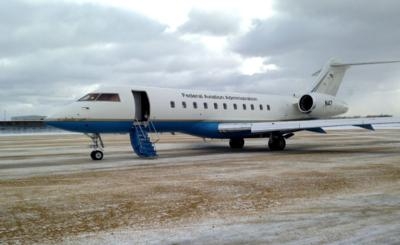FAA Bombardier Global 5000 Test Aircraft Used In The Demonstration
For the first time ever, a team of engineers at NASA’s Glenn Research Center conveyed aviation data -- including route options and weather information -- to an airplane over a wireless communication system for aircraft on the ground.

The demonstration, which was conducted at Glenn’s Communications, Navigation and Surveillance (CNS) test bed in collaboration with the FAA and Hitachi, LTD on Feb. 11, demonstrated two technologies that could change airport operations worldwide.
“This was the first time we provided this type of information to an airplane over a ground wireless network,” said Paul Nelson, Glenn’s project manager for Cyber-Security and Secure Communications, Navigation and Surveillance (CNS).
The team used an Aircraft Access to System Wide Information Management (SWIM), or AAtS, prototype technical solution to convey the aviation information to an FAA Bombardier Global 5000 test aircraft taxiing 60 to 70 miles per hour on the Cleveland Hopkins International Airport runway. They sent the information over a new wireless communication system called Aeronautical Mobile Airport Communications System, or AeroMACS.
The prototype AeroMACS hardware was developed by Hitachi. The system is based on WiMAX wireless communication standards, but uses different frequencies to enable connectivity on the ground. AAtS is an FAA technology demonstration and prototype initiative that enables solutions for connecting aircraft and flight crews to common-sourced aeronautical, weather and flight information. The AeroMACS demonstration enabled connectivity to allow updates to weather, airport status and flight and flow information prior to takeoff.
Until now, pilots have relied on voice communication with air traffic control or their airline operations center for this type of information because traditional wireless technologies don’t support high data throughputs. Together, AAtS and AeroMACS will improve situational awareness and reduce the potential for human error by giving pilots access to the information they need to make decisions. The trials consisted of three test cases designed to evaluate performance of both the AAtS and AeroMACS technologies. The trials demonstrated that AeroMACS can simultaneously transport multiple services seamlessly.
“It performed very well; it passed the test,” said Rafael Apaza, the AeroMACS technical lead. “We were able to send multiple applications to the aircraft at the same time and exchange surveillance and advisory flight information with fixed facilities without losing any data. This wireless communications capability will deliver great benefits to U.S. airport operations.”
In addition to improving safety, Nelson said the new wireless technology could allow airports to grow and change more affordably by replacing old underground systems.
“Airport communication systems use a lot of underground cables, which makes repairs and changes difficult,” he said. “Replacing and eliminating the underground infrastructure with wireless technology will reduce maintenance costs and downtime and allow airports to enhance capabilities more quickly.”
Glenn began investigating wireless communication technology for airports in 2004 and has worked with government and industry partners worldwide to develop AeroMACS and the wireless network standards.
The next steps for AeroMACS will include end-to-end testing involving multiple airports and evaluation of security measures.
(Image provided with NASA news release)
 ANN's Daily Aero-Term (04.26.24): DETRESFA (Distress Phrase)
ANN's Daily Aero-Term (04.26.24): DETRESFA (Distress Phrase) ANN's Daily Aero-Linx (04.26.24)
ANN's Daily Aero-Linx (04.26.24) Airborne 04.22.24: Rotor X Worsens, Airport Fees 4 FNB?, USMC Drone Pilot
Airborne 04.22.24: Rotor X Worsens, Airport Fees 4 FNB?, USMC Drone Pilot Airborne 04.24.24: INTEGRAL E, Elixir USA, M700 RVSM
Airborne 04.24.24: INTEGRAL E, Elixir USA, M700 RVSM Airborne-NextGen 04.23.24: UAVOS UVH 170, magni650 Engine, World eVTOL Directory
Airborne-NextGen 04.23.24: UAVOS UVH 170, magni650 Engine, World eVTOL Directory



